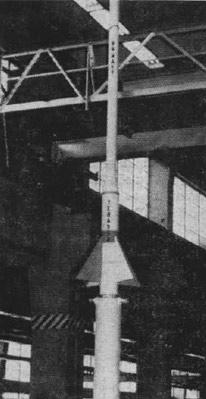Top Qs
Timeline
Chat
Perspective
Terasca
From Wikipedia, the free encyclopedia
Remove ads
Terasca, or Terrier-ASROC-Cajun, was an American three-stage sounding rocket developed and launched by the United States Navy. Derived from a combination of the Terrier, ASROC and Cajun rockets, three launches were attempted during 1959, but only one was successful.
Remove ads
Design and development
The Terrier-ASROC-Cajun ("Terasca") rocket was developed during early 1959 by the Naval Ordnance Test Station, located at China Lake, California, to fill a U.S. Navy requirement for a three-stage sounding rocket, intended to launch experimental payloads for conducting high-altitude research.[1][2] The rocket utilised a combination of existing missiles in its construction; the first stage was a Terrier surface-to-air missile; an ASROC anti-submarine rocket made up the second stage, while a Cajun sounding rocket was utilised as a third stage.[3]
The Terrier first stage produced 58,000 lbf (258 kN) thrust,[3] while the ASROC second stage provided 11,000 lbf (49 kN),[4] and the third-stage Cajun motor had a thrust rated at 8,100 lbf (36 kN).[3] The theoretical apogee for Terasca was 98 miles (158 km); it could carry a scientific payload of up to 25 pounds (11 kg).[5]
Remove ads
Operational history
Three launch attempts of the Terasca missile were made from the launch facility at Vandenberg Air Force Base during 1959, utilising the Western Launch and Test Range. The first launch attempt took place on May 1; this launch was a failure.[3][6] A second launch attempt on June 26, however, was successful, with the rocket reaching an apogee of 60 miles (97 km).[3][6] A third launch, attempted on August 12, however, was also a failure;[6] following the third launch, the Terasca program came to a close.[3]
Remove ads
Launch history
References
Wikiwand - on
Seamless Wikipedia browsing. On steroids.
Remove ads

